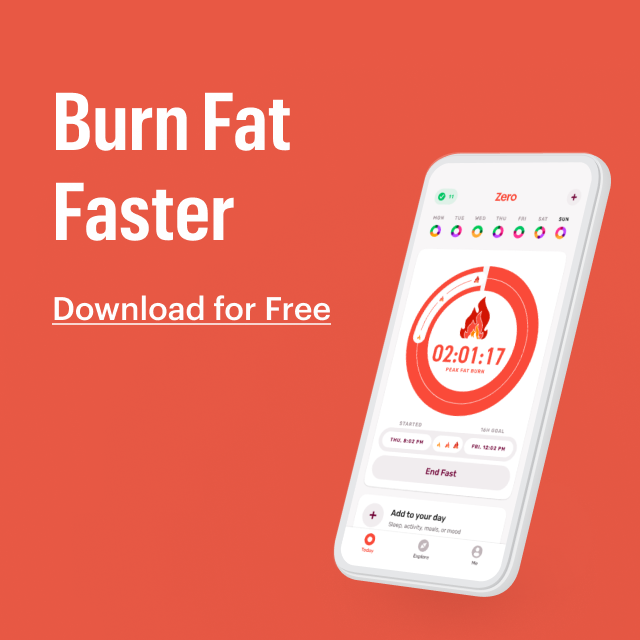Written and medically reviewed by Katya Meyers, RD
If you’ve ever tried to lose weight by counting calories, you know it can be a tedious affair. After all, life is busy, and it can be tough to keep track of the important things — dentist appointments and friends’ birthdays, for example — nevermind painstakingly measuring each ingredient in your morning smoothie or trying to recall exactly how many hors d’oeuvres you had at last night’s party. When it comes down to it, counting calories can all feel a bit “much.”
Alternatively, intermittent fasting is a straightforward, simple approach that has been shown to promote spontaneous caloric reduction and weight loss, and it comes with no calculator, no food scales, and no complicated dieting. Instead of focusing on tallying up calories from each and every bite you consume, intermittent fasting focuses only on when you eat. Yet, despite its simplicity, intermittent fasting is an effective approach that aligns with your body’s natural physiology to help you lose weight and improve your metabolic health.

So, What’s the Verdict on Calorie Counting?
First of all, what is a calorie? Most people think of calories as the nutritional value of a food, but in the truest sense, a calorie is simply a measure of energy. Specifically, a calorie is the amount of energy required to raise the temperature of 1 gram of water by 1 degree Celsius. Your body requires this energy for completing daily tasks, like running, breathing, and even thinking.
However, despite this seemingly straightforward relationship, there are a number of reasons why counting calories long term is likely not a sustainable nor effective approach. Counting calories accurately is notoriously difficult and requires a tremendous amount of mental resources. Few people want to be bound to measuring spoons and food scales, yet differences in portion sizes or forgotten add-ons (like sauces, dressings, or cooking oils) can lead to measurement errors of hundreds of calories per day.
Not to mention, it can be nearly impossible to know exact ingredients or serving sizes when eating out. Even if the energy content is listed on the menu or the back of a package label, it may not be entirely accurate; research has shown underestimates of between 8–200% for some commercially prepared foods. It’s also nearly impossible to track your calories in real time — you didn’t actually write down what was on your plate during that dinner party, did you? — and studies evaluating the accuracy of 24-hour diet recall show an average underestimation of 23–40%.
And, lest you forget, tracking incoming calories is only one half of the equation. Yes, you burn calories during exercise, but for the majority of individuals (everyone except the hardcore athletes), your non-exercise activity thermogenesis (NEAT) — things like standing, washing dishes, and fidgeting — constitutes the majority of calories expended in a day. NEAT can vary dramatically day to day, and, since it doesn’t include purposeful movement, it’s virtually impossible to track. Your body will also reduce its basal metabolic rate — which controls things like hormone production, breathing rates, and temperature regulation — in response to caloric restriction. All this to say that it is nearly impossible to know with much accuracy or precision how many calories you are consuming or expending.
But, even with perfect knowledge, adhering to a reduced calorie diet is… well, TOUGH. Research shows that dietary adherence is strongly correlated to weight loss, but that it begins to wane at around -20% below maintenance levels — a level far above what is often recommended in popular reduced-calorie diets. Some research shows that weight loss recidivism rates are as high as 94% after 6 years, following traditional weight loss interventions.
So, while it may be a good idea to log food occasionally to get a more detailed picture of your overall diet quality and bring awareness to your hunger levels, dogmatically counting calories is typically a cumbersome, inaccurate, and unsustainable method of weight loss.
Fasting vs. Calorie Counting
Fasting offers an alternative to calorie counting that many find to be simple, effective, and more sustainable than traditional calorie counting. Unlike traditional diets, which are based on caloric restriction, intermittent fasting narrows the eating window but does not restrict what or how much you choose to eat.
Recent research demonstrates that fasting is at least as effective in the short term as dieting in reducing weight, insulin resistance, and chronic inflammation. In the long-term, fasting enables sustainable weight loss — a 52-week observational study suggests time-restricted feeding is two times more effective in maintaining weight-loss success and avoiding weight regain. In addition, fasting provides benefits to your metabolic health that simply counting calories won’t target.
Such benefits include…
- Cell autophagy, an important cellular-waste removal process that can help protect against cancer, is activated in fasts longer than 16 hours.
- Increased metabolic flexibility, or the ability to switch between using glucose and stored fats for fuel. Research shows that flipping this metabolic switch helps to mobilize fat in the form of free fatty acids and ketones, which may have benefits in the treatment of metabolic syndrome and type-2 diabetes.
- Improved brain health. Fasting promotes the release of BDNF, which encourages memory formation and protects against neurodegenerative disease, such as Parkinson’s and Alzheimer’s.
- Fasting aligns with your body’s natural circadian rhythm, allowing you to take advantage of periods of naturally higher metabolic activity. Current studies on meal timing show that early fasting in particular can help lower blood sugar (glucose) levels, manage weight, and improve body composition.
- A fasting window is a prime moment of intentionality, where other habits, such as exercise, are amplified, thus accelerating things like weight loss.
Not only is fasting particularly effective at improving your health across a wide range of parameters, it’s also easy. Intermittent fasting offers an uncomplicated approach that doesn’t involve complex rules around eating new foods or avoiding your favorite ones. Research shows that the number of decision points needed to carry out change on a daily basis and the complexity of required changes are primary factors in adhering to behavioral change. Therefore, the binary approach of fasting may be just what you need to make healthy changes that will last.
How to Transition from Counting Calories to Counting Time
So, how do you make the switch from counting calories to counting time? The good news is that it doesn’t have to happen all at once. If you’ve been tracking calories regularly, you might be nervous about losing that control; if that’s the case, start with 1–2 days per week of counting time, and build from there.
#1) Choose a Fasting Regimen That’s Right for You
There are many types of fasting that exist, and you don’t need to jump in with both feet. Start by pushing breakfast back and dinner forward by 30 minutes, and see how your body responds. Gradually build to a fasting duration and frequency that aligns with your hunger cues and goals. The right fasting schedule for you is one that you can maintain on most days of the week.
#2) Focus on Minimally Processed Foods
While there are no specific diet rules with intermittent fasting, a high-quality diet, based on plenty of fruits, vegetables, meats, eggs, nuts, and lentils, will help you reach your goals sooner. Additionally, when you reduce the amount of simple carbohydrates (white breads, sodas, and most desserts), you’ll likely have an easier time meeting your fasting goal since your body will have fewer glucose peaks and crashes. Avoiding extreme swings in blood-sugar levels can keep energy and mood stable and cravings at bay until your fasting window ends.
#3) Pack in the Protein and Fiber
In a similar vein, including plenty of protein and fiber in your diet can help you feel full, reduce cravings, and improve body composition. Prioritizing protein by aiming for 20–40 g of protein per meal (think lean meats, cheese, tofu, lentils, and even the occasional protein powder) will improve satiety and optimize muscle-protein synthesis. Additionally, including plenty of fruits and vegetables, as well as whole grains, can help you meet your fiber recommendations. Fiber-rich foods take up space in your stomach, slow digestion, and help you feel fuller for longer.
#4) Listen to Your Body’s Cues
If you’ve been tracking calories and macros for a while, you’re probably used to exact measurements and calorie allotments that prescribe how much you eat — not the other way around. But if you slow down and tune into your body’s internal hunger and fullness cues, you can put away your food scales and, over time, learn to trust your body to tell you when it’s time to stop.
#5) Stay Accountable
Bringing friends and family along for your health journey is always a good idea, but if they’re not around (or if you’re looking for specific features or science-backed guidance), Zero is a great companion that can keep you motivated and accountable. To really check in with — and zoom out of — your nutrition, you can log your fasts, meals, and moods to track the relationship between when you fast, what you eat, and how you feel.
Conclusion: Time > Calories
Remember, improving your health doesn’t need to be complicated. Fasting provides an easy and sustainable alternative to calorie counting, and it comes with additional health benefits that you won’t get from calorie counting alone. Lengthening the amount of time you spend fasting each day, while still leaving plenty of room for proper nutrition and restoration, is a simple and effective way to improve your metabolic health and live a longer, healthier life.
- The Fasting Guide to Menopause, Perimenopause, and Postmenopause - April 8, 2024
- Try This Instead of That: How to Bookend Your Fasts - March 25, 2024
- 60 Names for Sugar: The Myths, The Facts, and What You Should Know - February 12, 2024






